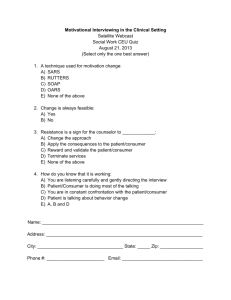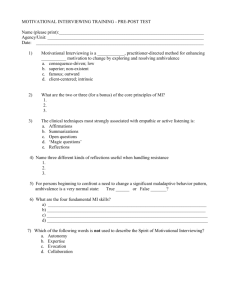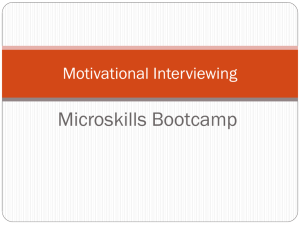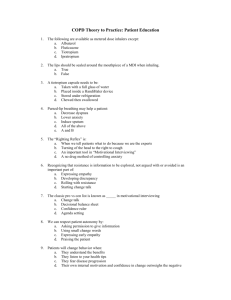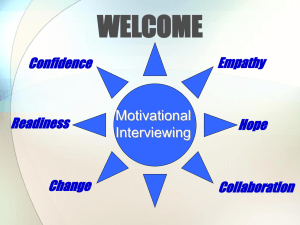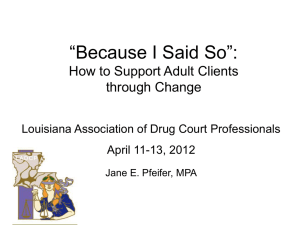Motivating Clients for Treatment and Addressing Resistance
advertisement
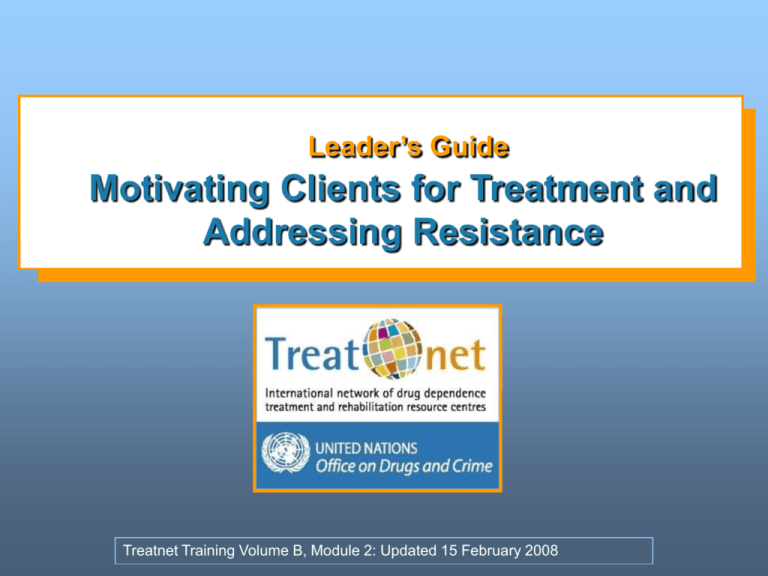
Leader’s Guide Motivating Clients for Treatment and Addressing Resistance Treatnet Training Volume B, Module 2: Updated 15 February 2008 Module 2 training goals: 1. Increase knowledge of motivational interviewing strategies and resources for substance abuse treatment 2. Increase skills in using motivating strategies and resources 3. Increase application of motivational strategies 2 Module 2: Workshops Workshop 1: Principles of Motivational Interviewing Workshop 2: How To Use Motivational Skills in Clinical Settings Workshop 3: Strategies to Avoid 3 Workshop 1: Principles of Motivational Interviewing Pre-assessment 10 Min. Please respond to the pre-assessment questions in your workbook. (Your responses are strictly confidential.) 5 What are we talking about? What does “increasing motivation” mean to you? 6 Workshop 1: Training objectives At the end of this workshop, you will be able to: 1. Understand the nature of motivation as it influences behavioural change 2. Understand the role of the clinician and client when using motivational strategies for behavioural change 3. Understand the Stages of Change Model and be able to identify a minimum of 3 components 4. Identify a minimum of 3 principles of motivational interviewing 7 An Introduction to Motivational Interviewing Preparing people for change Motivating clients: Definition Motivational interviewing is a directive, client-centred style of interaction aimed at helping people explore and resolve their ambivalence about their substance use and begin to make positive changes. 9 In other words… Many people who engage in harmful substance use do not fully recognise that they have a problem or that their other life problems are related to their use of drugs and/or alcohol. 10 It seems surprising… That people don’t simply stop using drugs, considering that drug addiction creates so many problems for them and their families. 11 However… People who engage in harmful drug or alcohol use often say they want to stop using, but they simply don’t know how, are unable to, or are not fully ready to stop. 12 Understanding How People Change: Models Traditional approach Motivating for change Traditional approach (1) The Stick Change is motivated by discomfort. If you can make people feel bad enough, they will change. People have to “hit bottom” to be ready for change Corollary: People don’t change if they haven’t suffered enough 14 Traditional approach (2) You better! Or else! If the stick is big enough, there is no need for a carrot. 15 Traditional approach (3) Someone who continues to use is “in denial.” The best way to “break through” the denial is direct confrontation. 16 Another approach: Motivating (1) People are ambivalent about change People continue their drug use because of their ambivalence The carrot 17 Ambivalence Ambivalence: Feeling two ways about something. All change contains an element of ambivalence. Resolving ambivalence in the direction of change is a key element of motivational interviewing 18 Another approach: Motivating (2) Motivation for change can be fostered by an accepting, empowering, and safe atmosphere The carrot 19 The Process of Change Why don’t people change? 20 You would think . . . that when a man has a heart attack, it would be enough to persuade him to quit smoking, change his diet, exercise more, and take his medication. 21 You would think . . . that hangovers, damaged relationships, an auto crash, memory blackouts ─ or even being pregnant ─ would be enough to convince a woman to stop drinking. 22 You would think… that experiencing the dehumanizing privations of prison would dissuade people from re-offending. 23 And yet… Harmful drug and alcohol use persist despite overwhelming evidence of their destructiveness. 24 Why don’t people change? What is the problem? It is NOT that… they don’t want to see (denial) they don’t care (no motivation) They are just in the early stages of change. 26 How do people change? Natural Change In many problem areas, positive change often occurs without formal treatment Stages and processes by which people change seem to be the same with or without treatment Treatment can be thought of as facilitating a natural process of change 28 Faith / Hope Effect A person’s perception of how likely it is that he/she can succeed in making a particular change is a good predictor of the likelihood that actual change will occur The effect of believing (placebo) often brings about 30% of the outcomes of treatment The doctor’s / counselor’s / teacher’s beliefs can become self-fulfilling prophecies 29 Brief Intervention Effect Brief interventions can trigger change 1 or 2 sessions can yield much greater change than no counselling A little counselling can lead to significant change Brief interventions can yield outcomes that are similar to those of longer treatments 30 Dose Effect It is reasonable to presume that the amount of change is related to the amount (dose ) of counselling / treatment received …but this is not always the case (!!) It is possible that treatment adherence and positive outcomes are related to some other factor – such as motivation for change 31 The Concept of Motivation (1) “Motivation can be defined as the probability that a person will enter into, continue, and adhere to a specific change strategy” (Council of Philosophical Studies, 1981) Motivation is a key to change Motivation is multidimensional Motivation is dynamic and fluctuating 32 The Concept of Motivation (2) Motivation is influenced by the clinician’s style Motivation can be modified The clinician’s task is to elicit and enhance motivation “Lack of motivation” is a challenge for the clinician’s therapeutic skills, not a fault for which to blame our clients 33 General Motivational Strategies giving ADVICE removing BARRIERS providing CHOICE decreasing DESIRABILITY practising EMPATHY providing FEEDBACK clarifying GOALS active HELPING 34 The Concept of Ambivalence (2) Ambivalence is normal clients usually enter treatment with fluctuating and conflicting motivations they “want to change and don’t want to change” “working with ambivalence is working with the heart of the problem” 35 Stages of Change 36 Activity 1: Reflection Take some time to think about the most difficult change that you had to make in your life. How much time did it take you to move from considering that change to actually taking action. 37 Stages of Change Recognising the need to change and understanding how to change doesn’t happen all at once. It usually takes time and patience. People often go through a series of “stages” as they begin to recognise that they have a problem. 38 First Stage: Pre-contemplation People at this stage: Are unaware of any problem related to their drug use Are unconcerned about their drug-use Ignore anyone else’s belief that they are doing something harmful 39 Second Stage: Contemplation People at this stage are considering whether or not to change: They enjoy using drugs, but They are sometimes worried about the increasing difficulties the use is causing. They are constantly debating with themselves whether or not they have a problem. 40 Third Stage: Determination/Preparation People at this stage are deciding how they are going to change ? They may be ready to change their behaviour They are getting ready to make the change It may take a long time to move to the next stage (action). 41 Fourth Stage: Action People at this stage: Have begun the process of changing Need help identifying realistic steps, highrisk situations, and new coping strategies 42 Fifth Stage: Maintenance People in this stage: Have made a change and Are working on maintaining the change 43 Relapse People at this stage have reinitiated the identified behaviour. People usually make several attempts to quit before being successful. The process of changing is rarely the same in subsequent attempts. Each attempt incorporates new information gained from the previous attempts. 44 Relapse Someone who has relapsed is NOT a failure! Relapse is part of the recovery process. 45 Stages of Change 46 Helping people change Helping people change involves increasing their awareness of their need to change and helping them to start moving through the stages of change. Start “where the client is” Positive approaches are more effective than confrontation – particularly in an outpatient setting. 47 Motivational Interviewing “People are better persuaded by the reasons they themselves discovered than those that come into the minds of others” Blaise Pascal Motivational Interviewing (MI) “MI is a directive, client-centered method for enhancing intrinsic motivation for change by exploring and resolving ambivalence” (Miller and Rollnick, 2002) “MI is a way of being with a client, not just a set of techniques for doing counseling” (Miller and Rollnick, 1991) 50 MI: Strategic goals Resolve ambivalence Avoid eliciting or strengthening resistance Elicit “Change Talk” from the client Enhance motivation and commitment for change Help the client go through the Stages of Change 51 MI - The Spirit (1) : Style Nonjudgemental and collaborative based on client and clinician partnership gently persuasive more supportive than argumentative listens rather than tells communicates respect for and acceptance for clients and their feelings 52 MI - The Spirit (2) : Style Explores client’s perceptions without labeling or correcting them no teaching, modeling, skill-training resistance is seen as an interpersonal behaviour pattern influenced by the clinician’s behavior resistance is met with reflection 53 MI - The Spirit (3) : Client Responsibility for change is left with the client Change arises from within rather than imposed from without Emphasis on client’s personal choice for deciding future behavior Focus on eliciting the client’s own concerns 54 MI - The Spirit (4) : Clinician Implies a strong sense of purpose Seeks to create and amplify the client’s discrepancy in order to enhance motivation Elicits possible change strategies from the client Systematically directs client toward motivation for change 55 Important considerations The clinician’s counselling style is one of the most important aspects of motivational interviewing: Use reflective listening and empathy Avoid confrontation Work as a team against “the problem” 56 Motivating for change Motivating for change Maintenance Action Determination/ Preparation Contemplation Pre-contemplation 57 Principles of Motivational Interviewing Principles of Motivational Interviewing Motivational interviewing is founded on 4 basic principles: Express empathy Develop discrepancy Roll with resistance Support self-efficacy 59 Principle 1: Express empathy The crucial attitude is one of acceptance Skillful reflective listening is fundamental to the client feeling understood and cared about Client ambivalence is normal; the clinician should demonstrate an understanding of the client’s perspective Labelling is unnecessary 60 Example of expressing empathy You drink wine to help you sleep. So you’re concerned about not having a job. I am so tired, but I cannot even sleep… So I drink some wine. …When I wake up…it is too late already… Yesterday my boss fired me. ...but I do not have a drinking problem! 61 Principle 2: Develop discrepancy Clarify important goals for the client Explore the consequences or potential consequences of the client’s current behaviours Create and amplify in the client’s mind a discrepancy between their current behaviour and their life goals 62 Example of developing discrepancy So drinking has some good things for you…now tell me about the not-so-good things you have experienced because of drinking. I enjoy having some drinks with my friends…that’s all. Drinking helps me relax and have fun…I think that I deserve that for a change… Well…as I said, I lost my job because of my drinking problem…and I often feel sick. 63 Principle 3: Roll with resistance Avoid arguing against resistance If it arises, stop and find another way to proceed Avoid confrontation Shift perceptions Invite, but do not impose, new perspectives Value the client as a resource for finding solutions to problems 64 Example of NOT rolling with resistance I do not want to stop drinking…as I said, I do not have a drinking problem…I want to drink when I feel like it. But, Anna, I think it is clear that drinking has caused you problems. You do not have the right to judge me. You don’t understand me. 65 Example of rolling with resistance You do have a drinking problem Others may think you have a problem, but you don’t. I do not want to stop drinking…as I said, I do not have a drinking problem…I want to drink when I feel like it. That’s right, my mother thinks that I have a problem, but she’s wrong. 66 Principle 4: Support self-efficacy Belief in the ability to change (selfefficacy) is an important motivator The client is responsible for choosing and carrying out personal change There is hope in the range of alternative approaches available 67 Example of supporting self-efficacy I am wondering if you can help me. I have failed many times. . . Anna, I don’t think you have failed because you are still here, hoping things can be better. As long as you are willing to stay in the process, I will support you. You have been successful before and you will be again. I hope things will be better this time. I’m willing to give it a try. 68 Questions? Comments? 69 Thank you for your time! End of Workshop 1 Workshop 2: How to Use Motivational Skills in Clinical Settings Training objectives At the end of this workshop, you will have: 1. Learned about and practised “Reflecting” 2. Learned and practised the OARS strategies, or micro-skills 3. Increased your empathic abilities by working with personal issues and roleplaying client issues 72 Techniques Learning the Micro-skills of Motivational Interviewing OARS The OARS are skills that can be used by interviewers to help move clients through the process of change. Open-ended questions Affirmation Reflective listening Summarising 74 OARS: Open-ended questions Open-ended questions: “What are the good things about your substance use?” vs. “Are there good things about using?” “Tell me about the not-so-good things about using” vs. “Are there bad things about using?” “You seem to have some concerns about your substance use. Tell me more about them.” vs. “Do you have concerns about your substance use?” “What most concerns you about that?” vs. “Do you worry a lot about using substances?” 75 OARS: Affirmation “Thanks for coming today.” “I appreciate that you are willing to talk to me about your substance use.” “You are obviously a resourceful person to have coped with those difficulties.” “That’s a good idea.” “It’s hard to talk about....I really appreciate your keeping on with this.” 76 Activity 2: Interviewing your Chief-of-State 10 Min. Write 10 open-ended questions and 10 affirmations for the president (prime minister, king, leader, etc.) of your country. Share your work with the rest of the group 77 OARS: Reflective listening Reflective listening is used to: Check out whether you really understood the client Highlight the client’s own motivation for change about substance use Steer the client towards a greater recognition of her or his problems and concerns, and Reinforce statements indicating that the client is thinking about change. 78 Practising forming reflections Complete the sentence, “One thing about myself I’d like to change is ________.” Divide into groups of three (one speaker, one listener, and one observer). Speaker talks for 5 minutes or so about the issue. Listener can only reflect. Observer checks to make sure no questions are asked – only reflections are made, which are statements. 79 OARS: Summarise Summarising is an important way of gathering together what has already been said, making sure you understood correctly, and preparing the client to move on. Summarising is putting together a group of reflections. 80 Activity 3: OARS role-playing 20 Min. Use the OARS form Observe the role-playing Pay special attention to the use of OARS skills Count the number of times that you observed any of these skills. Using the OARS form, take notes on the “clinician’s” behaviour as he/she displays OARS. 81 Activity 4: OARS rotating roles 35 Min. Use the OARS form Observe the role-playing Pay special attention to the use of OARS skills Count the number of times that you observed any of these skills. Using the OARS form, take notes on the “clinician’s” behaviour as he/she displays OARS. . 82 OARS: What is “change talk”? Change talk: An indication that you are successfully using motivational interviewing. If you are using MI successfully, you will hear statements that indicate the client’s: Desire to change Ability to change Reasons to change Need to change Commitment to change 83 Helping to elicit “change talk” (1) Ask open-ended questions, the answer to which is change talk. Ask the client to clarify their statements or elaborate: “Describe the last time this happened,” “Give me an example of that,” or “Tell me more about that.” 84 Helping to elicit “change talk” (2) Ask the client to imagine the worst consequences of not changing and the best consequences of changing. 85 Helping to elicit “change talk” (3) Explore the client’s goals and values to identify discrepancies between the client’s values and their current substance use. “What are the most important things in your life?” 86 Questions? Comments? 87 Thank you for your time! End of Workshop 2 Workshop 3: Strategies to avoid Training objectives At the end of this workshop, you will: 1. Know a minimum of 3 situations to avoid when using motivational strategies 2. Understand clinician traps 3. Understand Gordon’s 12 roadblocks 4. Have practised “the three chairs exercise” 90 What techniques should I avoid? Techniques to avoid when motivating clients: Confrontation Closed / denial questions Clinician traps Roadblocks to reflective listening 91 Clinician Traps Question-Answer Trap Confrontation-Denial Trap Expert Trap Labeling Trap Premature-Focus Trap Blaming Trap 92 Roadblocks 1 Ordering, directing, or commanding Warning or threatening Giving advice, making suggestions, providing solutions Persuading with logic, arguing, lecturing Moralising, preaching, telling them their duty Judging, criticising, disagreeing, blaming 93 Roadblocks 2 Agreeing, approving, praising Shaming, ridiculing, labeling, namecalling Interpreting, analysing Reassuring, sympathising, consoling Questioning, probing Withdrawing, distracting, humouring, changing the subject. 94 Some questions to ask yourself when in conversation with a client... What am I doing? Where are we going, and who’s deciding? What am I saying, and to what end? Am I actively listening? Are we dancing or wrestling? 95 Activity 8: The 3 Chairs exercise 15 Min. Observe the activity and provide feedback. 96 Questions? Comments? 97 Post-assessment 20 Min. Please respond to the postassessment questions in your workbook. (Your responses are strictly confidential.) 98 Thank you for your time! End of Workshop 3
